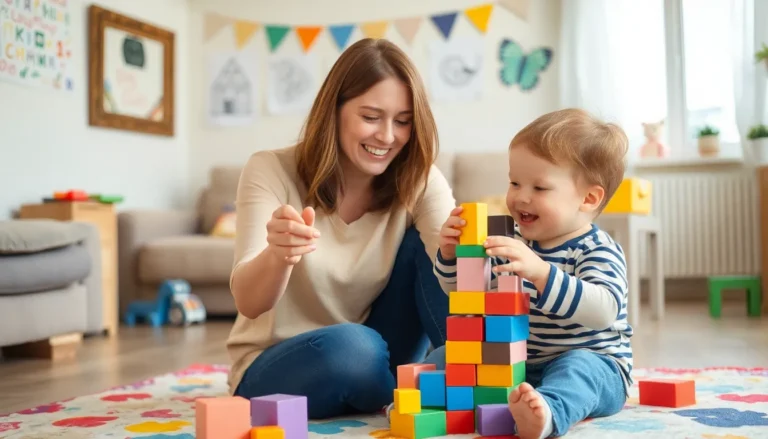Table of Contents
ToggleDisciplining a child can feel like trying to teach a cat to fetch—frustrating and often messy. Every parent knows that navigating the tricky waters of discipline is no walk in the park. It’s a delicate balance between setting boundaries and keeping the peace, all while maintaining your sanity.
But fear not! With the right strategies, discipline can transform from a daunting task into an opportunity for growth and connection. Whether it’s time-outs that feel like a mini vacation for parents or creative consequences that spark laughter, effective discipline doesn’t have to be a battle. Dive into the world of parenting wisdom and discover how to turn those challenging moments into teachable experiences that leave both you and your child smiling.
Understanding Discipline
Discipline shapes behavior and can significantly influence a child’s development. Effective discipline strategies foster a child’s emotional and social growth while helping them understand acceptable behavior.
Importance of Discipline
Discipline plays a crucial role in a child’s life. It teaches respect for boundaries. Setting clear expectations helps children feel secure. Consistent discipline encourages responsible decision-making. Positive reinforcement highlights desired behaviors and increases self-esteem. Children learn from mistakes when guidance is present, transforming misbehavior into teachable moments. With effective discipline, children develop self-control, essential for navigating relationships and society.
Types of Discipline Strategies
Numerous discipline strategies exist, each suited to different situations. Time-outs provide a pause for reflection, allowing children to regroup emotionally. Creative consequences link actions with outcomes, promoting accountability. Natural consequences let children experience results of behavior, reinforcing learning. Positive reinforcement recognizes good behavior, using praise or rewards to motivate. Parents might also establish routines, creating consistency that promotes good behavior patterns. With various strategies, parents can select approaches that best fit their child’s unique personality and needs.
Effective Discipline Techniques
Effective discipline techniques provide parents with the tools to promote healthy behavior in children. They foster understanding and respect while establishing a nurturing environment.
Positive Reinforcement
Positive reinforcement encourages good behavior by recognizing and rewarding desired actions. Parents can offer praise, stickers, or small privileges for achievements, enhancing a child’s motivation. Encouraging compliments on positive behavior builds self-esteem. Recognizing efforts rather than just results helps children associate good actions with positive outcomes. This method allows for a constructive approach to discipline, reinforcing the idea that good behavior leads to rewards.
Setting Clear Boundaries
Setting clear boundaries is crucial in guiding children’s behavior. Establishing consistent rules helps children understand expectations, creating a sense of security. Effective boundaries involve clear communication about what is acceptable and what is not. Parents can engage children in discussions about the reasons behind rules, promoting understanding and cooperation. Enforcing boundaries consistently ensures children learn the importance of rules while fostering mutual respect. Clear expectations prevent confusion and guide decision-making in various situations.
Common Mistakes to Avoid
Disciplining a child requires careful consideration. Common pitfalls can undermine effective strategies.
Consistency Issues
Inconsistent discipline creates confusion. Children struggle to understand expectations when rules change. Parents often waver in enforcement, undermining their authority. Consistency fosters a sense of security, allowing children to predict outcomes. Establishing fixed rules enhances clarity. Clear explanations can help children grasp the importance of guidelines. Regularly reviewing and maintaining these rules supports consistent behavior. Reinforcement of boundaries strengthens discipline efforts.
Using Harsh Punishments
Harsh punishments can have detrimental effects. Intimidation fosters fear rather than respect. Rather than teaching lessons, extreme measures can cause resentment. Parent-child relationships often suffer under harsh disciplinary methods. Instead of building resilience, fear impedes healthy emotional development. Positive discipline techniques achieve better long-term outcomes. Focusing on constructive consequences promotes understanding. Encouraging open communication also fosters trust, making discipline more effective. Choosing appropriate responses can help children learn from mistakes without damaging their self-esteem.
Tailoring Discipline to Age
Discipline strategies should reflect a child’s developmental stage for effectiveness. Parents can adapt methods based on age group to better guide behavior.
Discipline for Toddlers
Toddlers thrive with simple and consistent communication regarding boundaries. Time-outs offer a structured space for emotional regulation, allowing them to regroup. Positive reinforcement encourages desired actions, turning everyday achievements into celebrations. Redirecting attention helps children focus on acceptable behaviors, minimizing frustration. Reinforcing a routine nurtures a sense of security and predictability, essential for this age.
Discipline for Teenagers
Teenagers require a more sophisticated approach as they seek independence. Open discussions about expectations and consequences foster mutual respect. Setting clear rules helps establish boundaries while giving teens a sense of autonomy. Involving them in decision-making regarding consequences cultivates accountability. Reflective listening aids in understanding their perspectives, strengthening trust in the parent-child relationship. Positive reinforcement remains vital for recognizing good behavior and promoting self-esteem during these formative years.
Conclusion
Disciplining a child is a journey that requires patience and understanding. By employing effective strategies tailored to each child’s needs, parents can create an environment that fosters growth and respect. The balance between setting boundaries and nurturing a child’s emotional well-being is essential for building a strong parent-child relationship.
Through positive reinforcement and consistent communication, parents can help their children navigate challenges while encouraging responsible decision-making. Ultimately, the goal of discipline is not just to enforce rules but to guide children toward becoming confident and respectful individuals. With the right approach, discipline can transform into a valuable opportunity for learning and connection.








